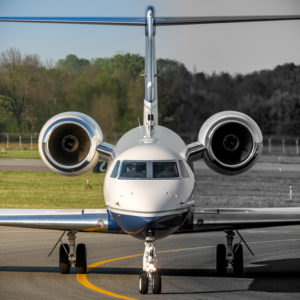 In February 2020, a Gulfstream G500 aircraft suffered a hard landing. The approach and landing occurred at night during somewhat windy conditions. Upon investigation, Gulfstream determined that large, rapidly alternating control-stick movements by the pilot flying caused the flight control system (FCS) to enter angle-of-attack (AOA) limiting mode, resulting in the FCS automatically commanding downward pitch of the aircraft to reduce AOA. The aircraft was just a few feet above touchdown above the runway when the automatic pitch-down occurred, resulting in higher rate of descent and then a hard landing. The FAA issued an airworthiness directive in May 2020, providing updates to the aircraft flight manual reminding pilots to avoid large control-stick movements.
In February 2020, a Gulfstream G500 aircraft suffered a hard landing. The approach and landing occurred at night during somewhat windy conditions. Upon investigation, Gulfstream determined that large, rapidly alternating control-stick movements by the pilot flying caused the flight control system (FCS) to enter angle-of-attack (AOA) limiting mode, resulting in the FCS automatically commanding downward pitch of the aircraft to reduce AOA. The aircraft was just a few feet above touchdown above the runway when the automatic pitch-down occurred, resulting in higher rate of descent and then a hard landing. The FAA issued an airworthiness directive in May 2020, providing updates to the aircraft flight manual reminding pilots to avoid large control-stick movements.
On April 4, 2022, a second G500 aircraft suffered a hard landing under similar circumstances. As a result of this second incident, on April 29, 2022, Gulfstream released a Maintenance and Operations Letter (MOL) to owners and operators of G500 aircraft, containing limitations on operations of these aircraft in certain wind conditions. A similar MOL was also released on April 29 to owners and operators of G600 aircraft (because the FCS software on the G500 and G600 are similar). At the time of writing of this article, Gulfstream expects the FAA to issue an airworthiness directive in early May 2022 making these operating limitations mandatory.
Although G500 and G600 have not been grounded, the new operating restrictions are significant. A G500/G600 may not land if the wind, from any direction, is more than 15 knots. Nor may an aircraft land if the wind gusts are more than 5 knots. In addition, landing approach speed must be increased by 10 knots, resulting in longer landing distances. There are additional requirements for use of autothrottles, and guidance from an ILS or other vertical guidance approach when landing at night, and other restrictions. Gulfstream anticipates that the FAA will certify a software update (version 9.5) to the G500 and G600 FCS in the fourth quarter of 2022. In the meantime, these restrictions may significantly limit the operation of the G500 and G600. It also seems likely that Part 135 charter flights will not be able to depart or be dispatched unless the required wind conditions at the destination are expressly forecast to be within limits.
This information is general in nature and, therefore, is not legal advice. Please contact one of our experienced aviation attorneys directly to discuss any legal questions you may have about aircraft ownership or operations.

